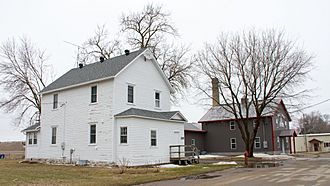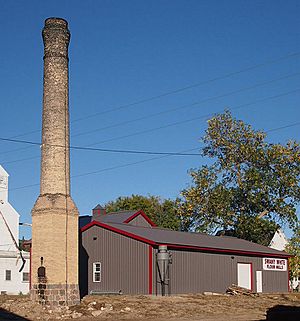Swany White Flour Mills facts for kids
Quick facts for kids Swany White Flour Mills |
|
|---|---|

The 1900 miller's house (left) and 2012 mill (right)
|
|
|
Freeport Roller Mill and Miller's House
|
|
|
Formerly listed on the U.S. National Register of Historic Places
|
|
| Location | 206–210 2nd Street SE, Freeport, Minnesota |
| Area | Less than one acre |
| Built | 1898 (mill), 1900 (house) |
| Architect | Anthony Hoeschen |
| MPS | Stearns County MRA |
| NRHP reference No. | 82003043 |
| Significant dates | |
| Added to NRHP | April 15, 1982 |
| Removed from NRHP | March 28, 2024 |
Swany White Flour Mills is a company in Freeport, Minnesota, USA. They make and sell flour. This company started in the late 1800s. The same family has owned it since 1903. In 2011, their old mill, which was 114 years old, burned down. But they built a new one the next year. Swany White Flour Mills kept making flour and stayed in business.
The mill buildings were once on the National Register of Historic Places. This is a list of important historical places in the United States. It was added in 1982. The site was called the Freeport Roller Mill and Miller's House. It was important for its role in local business. The original mill was built in 1898. It grew to three stories by 1912. The site also had a brick powerhouse, a miller's house from 1900, and an old smokestack. It was the last 19th-century mill still working in Minnesota. The miller's house and smokestack are still there today. The new mill, built in 2012, stands between them. The property was removed from the National Register in 2024.
Contents
History of the Mill
Starting the Mill
The person who built the first mill was Anton Hoeschen. He did not plan to run the mill himself. He saw it as a way to help the community. He hoped to find someone who wanted to be a miller. After a few years and different owners, Hubert and Peter Thelen bought the mill in 1903. They ran it together. They named their white flour "Swany White." This name suggested their flour was as white as a swan.
Growing the Business
In the early days, many small mills like this one were in Minnesota. Local farmers could sell their wheat close to home. They did not have to send it to big mills in Minneapolis. At the mill, farmers could sell their grain. They could also trade raw wheat for ground flour for their families.
In 1913, the Thelen brothers updated the mill. They added a basement and more space for making flour. These changes made the mill work better. It could make twice as much flour as before. Peter Thelen retired in 1953. His son, Walter, then took over the mill. In 1966, he changed the mill's old steam engine to an electric motor.
Staying in Business
Many other small mills closed down. This happened because large companies took over. Also, less wheat was grown in Minnesota. But Walter Thelen found a way to keep his mill open. He decided to make a slightly different product. In the 1970s, he asked organic farmers to grow organic wheat. He then made organic flour. He also made deals with special bakers in the area. His plan worked. Swany White organic flour was sold in food cooperatives and health food stores in Minnesota. He even sold flour as far away as the East Coast.
A Local Landmark
In 1982, the mill was put on the National Register of Historic Places. It was still a working mill. In 1998, Walter's son, Gary, bought the business from his father. By then, the Swany White Flour Mill was a famous place in Minnesota. A photographer named Richard Olsenius visited Freeport. He was looking for places that inspired Garrison Keillor's Lake Wobegon stories. He took pictures of Gary Thelen and his mill. People from local bread clubs also visited. They wanted to see how a century-old mill worked.
The Fire and Rebuilding
On December 27, 2011, the Swany White Mill burned down. No one was hurt. An employee reported the fire. It took more than five fire departments from nearby towns to put out the blaze. That night, many people watched their local landmark burn. Some held hands and cried. At first, Gary Thelen said he would not rebuild. But he changed his mind. A new Swany White mill opened in 2012.
How Flour is Made
For its white flour, Swany White used the same milling machines since 1913. It could make about 1,000 pounds of flour every hour. This means it could make about 12,000 pounds in one business day. This amount was much smaller than what most big mills could make. It is special that Swany White Flour kept working as a small, independent company. Most other small flour makers either stopped or sold their businesses.
Swany White sold its regular flour mostly in the Upper Midwest region. But its organic products were sold in many more places. Besides selling to stores, Swany White also had a small shop at the mill in Freeport. The mill's most popular product was a bleached flour. It was sold under the name Faith's Best. This flour made up about 60% of all their sales.
See also




